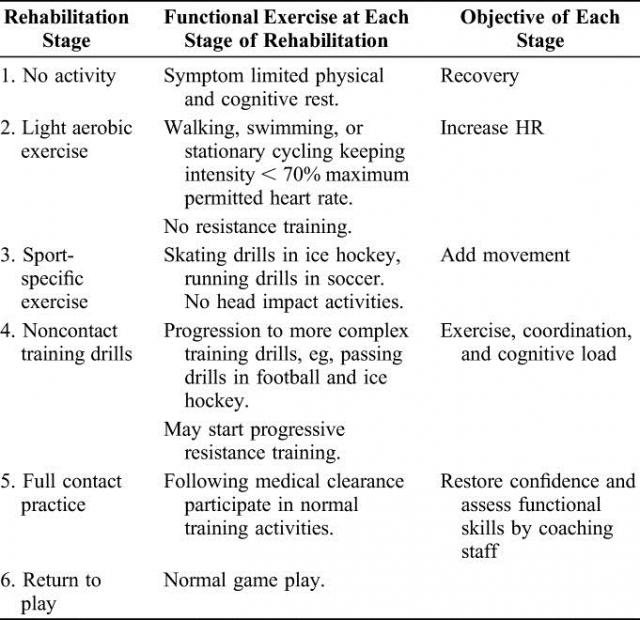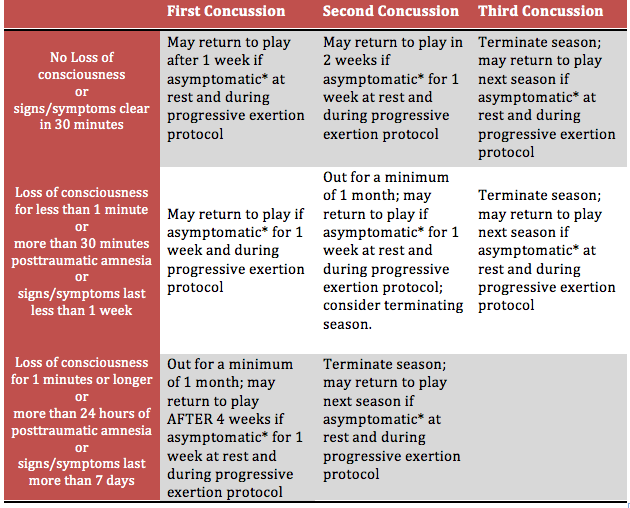|
Consensus Statement on Concussion in Sport-the 4th International Conference on Concussion in Sport Held in Zurich, November 2012 (McCrory et al. 2013)
|
|
|
Cantu Return to Play Guidelines
|
|
|
Centers for Disease Control & Prevention Return to Play Guidelines Baseline (Step 0): As the baseline step of the Return to Play Progression, the athlete needs to have completed physical and cognitive rest and not be experiencing concussion symptoms for a minimum of 24 hours. Keep in mind, the younger the athlete, the more conservative the treatment.
Step 1: Light Aerobic Exercise
The Goal: only to increase an athlete's heart rate.
Step 2: Moderate Exercise
The Goal: limited body and head movement. Step 3: Non-contact Exercise
The Goal: more intense but non-contact Step 4: Practice The Goal: Reintegrate in full contact practice. Step 5: Play The Goal: Return to competitionIt is important to monitor symptoms and cognitive function carefully during each increase of exertion. Athletes should only progress to the next level of exertion if they are not experiencing symptoms at the current level. If symptoms return at any step, an athlete should stop these activities as this may be a sign the athlete is pushing too hard. Only after additional rest, when the athlete is once again not experiencing symptoms for a minimum of 24 hours, should he or she start again at the previous step during which symptoms were experienced. The Return to Play Progression process is best conducted through a team approach and by a health professional who knows the athlete's physical abilities and endurance. By gauging the athlete's performance on each individual step, a health care professional will be able to determine how far to progress the athlete on a given day. In some cases, the athlete may be able to work through one step in a single day, while in other cases it may take several days to work through an individual step. It may take several weeks to months to work through the entire 5-step progression.
|
|
|
American Academy of Neurology 2013 Evidence-Based Concussion Management Guidelines (Giza C, 2013)
RTP: Graded Physical Activity LHCPs might develop individualized graded plans for return to physical and |
1. Broglio SP, et al. National Athletic Trainers' Association Position Statement: Management of Sport Concussion. J Athl Train. 2014;49(1):000-000. doi: 10.4085/1062-6050-49.1.07 (epub March 10, 2014).
2. Giza C, Kutcher J, Ashwal S, et al. Summary of evidence-based guideline update: Evaluation and management of concussion in sports: Report of the Guideline Development Subcommittee of the American Academy of Neurologists. Neurology 2013;DOI:10.1212/WNL.0b013e31828d57dd (published online ahead of print March 18, 2013)(https://www.aan.com/uploadedFiles/Website_Library_Assets/Documents/3Prac...)
3. Halstead, ME, Walter, K. Clinical Report - Sport-Related Concussion in Children and Adolescents. Pediatrics. 2010;126(3):597-615 (http://pediatrics.aappublications.org/content/126/3/597.full.pdf+html)
4. Halstead ME, et al. Clinical Report: Returning to Learning Following a Concussion. Pediatrics 2013;doi:10.1542/peds.2013-2867 (epub October 27, 2013)( http://pediatrics.aappublications.org/content/132/5/948.full.pdf+html)
5. Hollis SJ, Stevenson MR, McIntosh AS, et al. Incidence, risk, and protective factors of mild traumatic brain injury in a cohort of Australian nonprofessional male rugby players. Am J Sports Med. 2009;37:2328-33.
6. May KH, Marshall DL, Burns TG, Popoli DM, Polikandriotis JA. Pediatric Sports Specific Return to Play Guidelines Following Concussion. Int'l J Sports Phys. Therapy. 2014;9(2):242-255).7. McCrory P, Meeuwisse W, Johnston K, Dvorak J, Aubry M, Molloy M. et al. Consensus Statement on Concussion in Sport: the 3rd International Conference on Concussion in Sport held in Zurich, November 2008. Br J Sports Med 2009; 43(Suppl. 1):i76-i90.
8. McCrory P, Meeuwisse W, Aubry M, Cantu, R. Consensus Statement on Concussion in Sport-the 4th International Conference on Concussion in Sport Held in Zurich, November 2012. Clin J Sport Med. 2013;23(2):89-117. http://journals.lww.com/cjsportsmed/Fulltext/2013/03000/Consensus_Statement_on_Concussion_in_Sport_the_4th.1.aspx
9. Sye G, Sullivan SJ, McCrory P. High school rugby players' understanding of concussion and return to play guidelines. Br J Sports Med. 2006;40:1003-5.
10. Yard EE, Comstock RD. Compliance with return to play guidelines following concussion in US high school athletes, 2005-2008. Brain Inj. 2009;23:888-98.
Posted June 16, 2014; revised June 18, 2014










